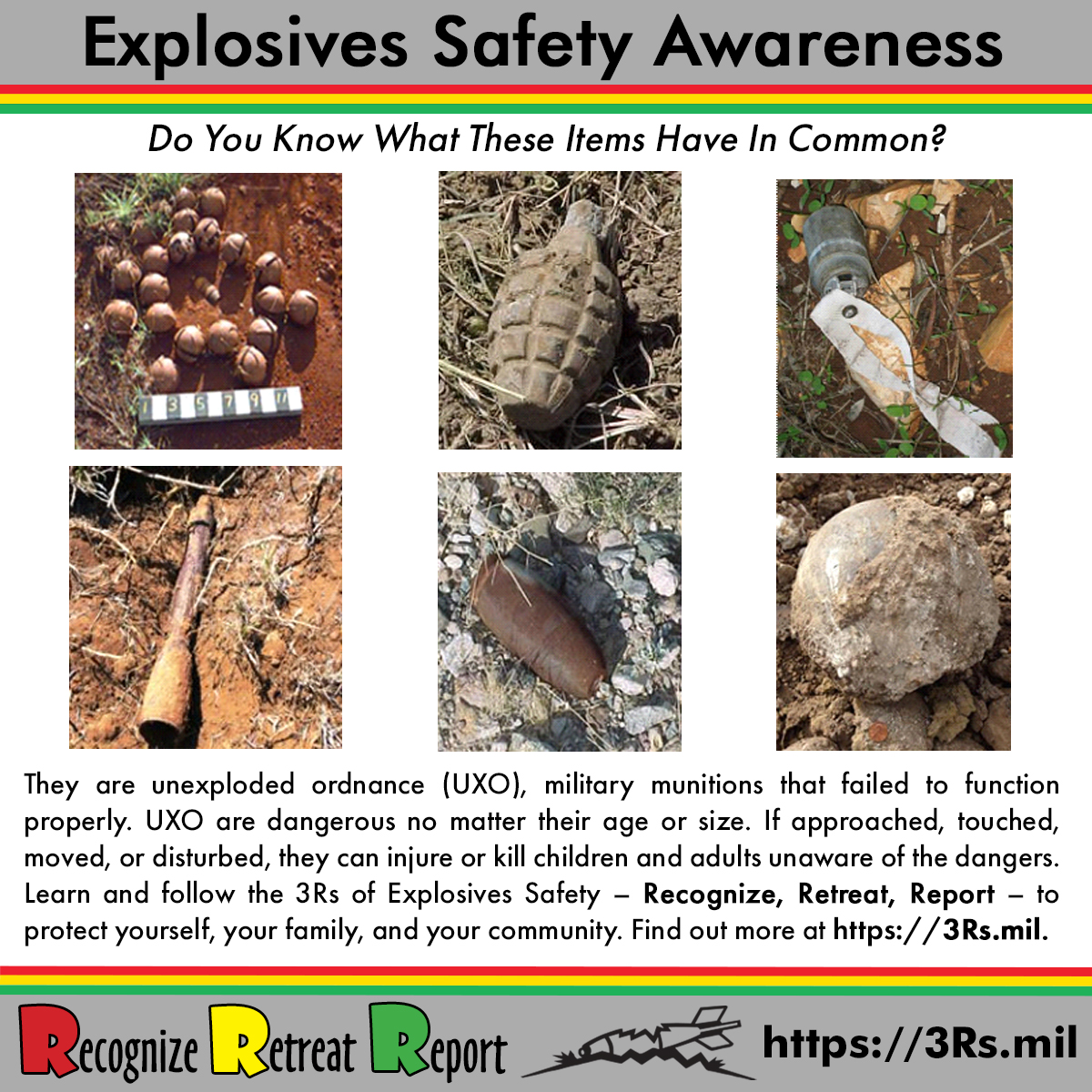
RECOGNIZE, RETREAT, REPORT – These are the 3Rs of Explosives Safety.
Safety is one of many important responsibilities of the U.S. Army. To address explosives safety, the U.S. Army developed the Department of Defense’s 3Rs (Recognize, Retreat, Report) Explosives Safety Education Program (3Rs Program). (Visit 3Rs.mil for more information.)
The Office of the Deputy Assistant Secretary of the Army for Environment, Safety and Occupational Health developed the Army’s 3Rs Program in 2000 after a teenager was killed and another critically injured when an anti-tank projectile that they had removed from an operational range detonated.
The 3Rs Program educates soldiers, families, workers, and communities about the dangers associated with munitions and the actions to take if they encounter or suspect they have encountered a munition. The 3Rs Program’s message is simple:

— when you see a munition and that it is dangerous;
— do not touch it, but carefully leave the area;
— call 911 to tell the police what you saw and where.
In its 243-year history, the U.S. Armed Forces have conducted and continue to conduct live-fire training to be prepared to defend our Nation. This training involves the use of various types of munitions including bombs, artillery projectiles, grenades, mines, rockets, and simulators. Some munitions do not explode or function as intended. These are called unexploded ordnance or UXO.
In some cases, property the military once used for training has transferred from the military’s control to public uses such as parks or has become private property. Given its past military use, munitions may be encountered within property the military no longer controls or uses. Munitions are dangerous, even decades after they were used or made. Civil War cannonballs, which are often collected as souvenirs, may contain an explosive fill that if subjected to a spark, fire, or heat will explode. Other munitions kept as souvenirs may be more dangerous, even if kept and handled for years. Because munitions may be encountered anywhere, it is important to learn and follow the 3Rs of explosives safety.
Munitions may not look like a bullet or bomb. They may look harmless, be shiny or rusty, or clean or dirty. Regardless of what they look like, munitions should be considered dangerous. Do not approach, touch, pick up, or move a munition or suspect munition. Even if a munition was disturbed or moved once, it may explode. Call 911, and let the police request support from DoD Explosives Ordnance Disposal personnel to locate and dispose of the munition safely.
By learning and following the 3Rs of explosives safety, everyone can protect themselves, their family, friends, and community from the dangers associated with munitions.
The Army is executing a 3Rs Program at both active Army installations and formerly used defense sites to enhance and increase the effectiveness of the 3Rs message. The goal is to expand the 3Rs education and awareness initiative and support installations in assessments, customizing outreach material, conducting training workshops, assessing program effectiveness, and sharing lessons learned. Additionally, the Army and its contractors provide staff support at public outreach events supplying outreach booths equipped with games, educational resources, and mascot performers to publicize further the 3Rs message. Currently, the 3Rs Program is assisting 25 active Army and National Guard installations. In the future, the 3Rs Program will expand to assist additional installations.
For more information about the 3Rs, including videos and other educational resources that can be used to teach everyone about the 3Rs Program, visit: https://3Rs.mil.



